The Kingdom of Ruhuna
Godavaya is located on the coast of Sri Lanka. Here Sri Lankan and German archaeologists excavate the old Kingdom of Ruhuna, gathering evidence of its glorious past. Excavations have been carried out since 1994, under Professor Helmut Roth of the University of Bonn in Germany, along with the Sri Lankan Archaeological Department, directed by Director General Dr. W. H. Wijeyapala, and the German Archaeological Institute (DAI).
Recently they excavated the temple area of Gotha Pabbatha Rajamaha Vihara in Godavaya. The temple area was not only religious, but it was also used as an administrative centre during the reign of King Gajabahu I. A unique Brahmi inscription on a rock next to the ancient shrine room clearly states that this was indeed a significant sea-trading place. True to Sri Lankan tradition, Ahalaya, one of King Gajabahu’s ministers, has immortalized himself by getting his name carved in an inscription on this rock.
In ancient times, Sri Lanka was heavily involved in the sea trade and exported dark red garnets. Up to the 7th century AD, these semi-precious stones were found as burial objects as far away as European graves. New research has now revealed that most of those garnets were from India and Sri Lanka. Spices were also exported from the island. The dig has uncovered Sassanian (Persian) and Chinese pottery as well as Roman coins.
Ships from the East carrying silk from China exchanged their commodities with merchandise from the West in the transit harbor of Godavaya, as trade ships from both directions usually did not go farther than Sri Lanka. Therefore, the Kingdom of Ruhuna played an important role as a trade center in early East-West trade. Godavaya was active in sea trade up until the 6th century AD. Along with trade items from Arabia and China, local articles of trade arrived via the local river.
The harbor town of Godavaya is mentioned in the Mahawamsa’s chapter on “The 12 Kings”. Even in early western books like the Topographia Christiana of the 6th century AD, Sri Lanka is referred to as an important sea trade centre on the Silk Route. Sri Lanka is also mentioned in The Periplus Maris Erythraei, a guide to trade on the Red Sea and India, writen by an author in Alexandria, supposed around 40 AD.
On top of the rock overlooking the entire area was a monastery, which dates back to the 2nd century AD. On the west side of the monastery an elevated ancient image house (Buddhu gedera) and a chapter house (Dharma salawa) have been excavated.
Three different statues were discovered here: A standing Buddha about 3.50 meters tall and two Bodhisattva statues each about 1.80 meters in height. These statues even have traces of the original color. The source of the color is still a mystery, but it has withstood the weather over many centuries.
Historians have been especially interested in the Customs Building, located on the east side of the ancient monastery, which was decorated with ornaments showing an elephant placing his trunk in lotus flowers. Normally, only the King was allowed to collect taxes. In Godavaya, the tax fees were donated to the temple for its maintenance. Clay seals bearing the emblem of a lion were used to seal goods and cargo as proof that the customs duty was paid.
At the bottom of the rock was the settlement of Godapavata Pattana, sandwiched on the peninsula between the Walawe River’s inland harbor and the sea harbor in the bay of Godavaya. A landing jetty constructed of stone pillars up to 3.50 meters high was part of the ancient harbor. While doing an underwater survey, the excavation team found one of the four ancient stone anchors discovered so far in Sri Lanka, the other three being found in Galle.
Several Roman coins, beads, bangles, bricks showing guild marks in the shape of an O, a huge selection of pottery and rich decorations used for roofs and houses give clear evidence of a once prosperous time. A quarry was also discovered. One large pillar covered with many drill marks dating to the middle Anuradhapura period before the 5th century AD, lies in front of the huge rock close to the ocean. This is quite notable, as very few quarries have been documented.
Stone anchors from Arabia
Several stone anchors have been found in Shri Lanka’s waters, clustered together near the Black Fort in the area of Kamba Bandina Gala, a traditional mooring site for the lighter vessels which ferried cargo between large ships and the jetties. Anchors are not only found in association with wrecks: ships lose anchors frequently, because they jam or because they are not properly secured. Some old anchors may also be used as fixed moorings.
One large anchor of Arab-Indian pattern was recovered in 1997, and two broken anchors of similar type have been found. Several dozen of these anchors have been found in the Indian Ocean and the Red Sea, with the largest concentrations near Qalhat in Oman. The stone of the large anchor has been analysed, and is also believed to be from Arabia. The anchor is estimated to weigh almost a ton, so must have belonged to a ship of some size. It bears witness to the Arabian vessels which sailed the sea route to China and are believed to have dominated regional trade until the arrival of the Europeans.
Under the large anchor were two pieces of dense hardwood, in a position suggesting that these were the arms of the anchor. This is the first time that wood has been found in association with one of these anchors. Analysis has shown that the timber could be from the fifteenth century, preceding the arrival of the Portuguese. The anchor itself may of course be older, as timber arms would have required frequent replacement.
One anchor was found of Mediterranean pattern, known as the Byzantine-Arab style. These anchors were used in ancient times, from the time of the Kingdom of Ruhuna until recently in the Persian Gulf.
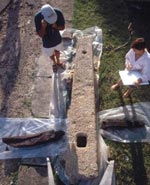
Above and Below: Large stone anchors near the Black Fort
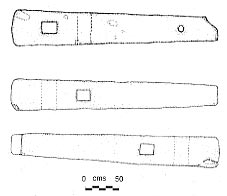
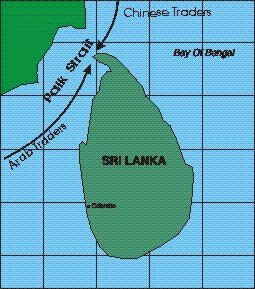
Trade on the Bay of Bengal
Located between India and the Malay Peninsula, the Bay of Bengal linked Eastern Asia with the Indian Sub-continent. On the Indian side, Madras and Pondcherry dominated the Chola Coast where ships set sail for Eastern Asia. Other ships on the maritime trade route between Rome and China passed through Sri Lanka. Often Indian ships collected these cargos and set out for Eastern Asia. In order to reach Vietnam or China the ships had to pass through the Straits of Malacca. This was considered a dangerous voyage, where ruthless “sea gypsies” or pirates were known to lurk. An option to this, was to unload the cargo on the shore and pay the local people to transport it across the Isthmus of Kra to the far coast where Chinese Junks could collect it. Since this was a difficult undertaking, the majority of trade passed through the Strait of Malacca. Cities overlooking the strait, such as Srivijar (near modern day Palembang) and Malacca became rich and powerful through trade and taxes on passing ships.
Malacca Port 250 BC - 250 AD
During the period between 250 BC and 250 AD, a maritime sea route existed between Alexandra in Northern Africa and China. As trade took place along this route, a number of kingdoms rose to power, flush with finances from trade. These kingdoms all came into being around the same time, and all waned around the same time. The map below illustrates the route. Arab and Indian Dhows sailed down the Red Sea to Palk Bay in Sri Lanka. Indian Dhows traveled from India as far as Malacca where they met Chinese junks. Some Chinese Junks traveled as far as Sri Lanka where they met Arabs. This route is illustrated below:
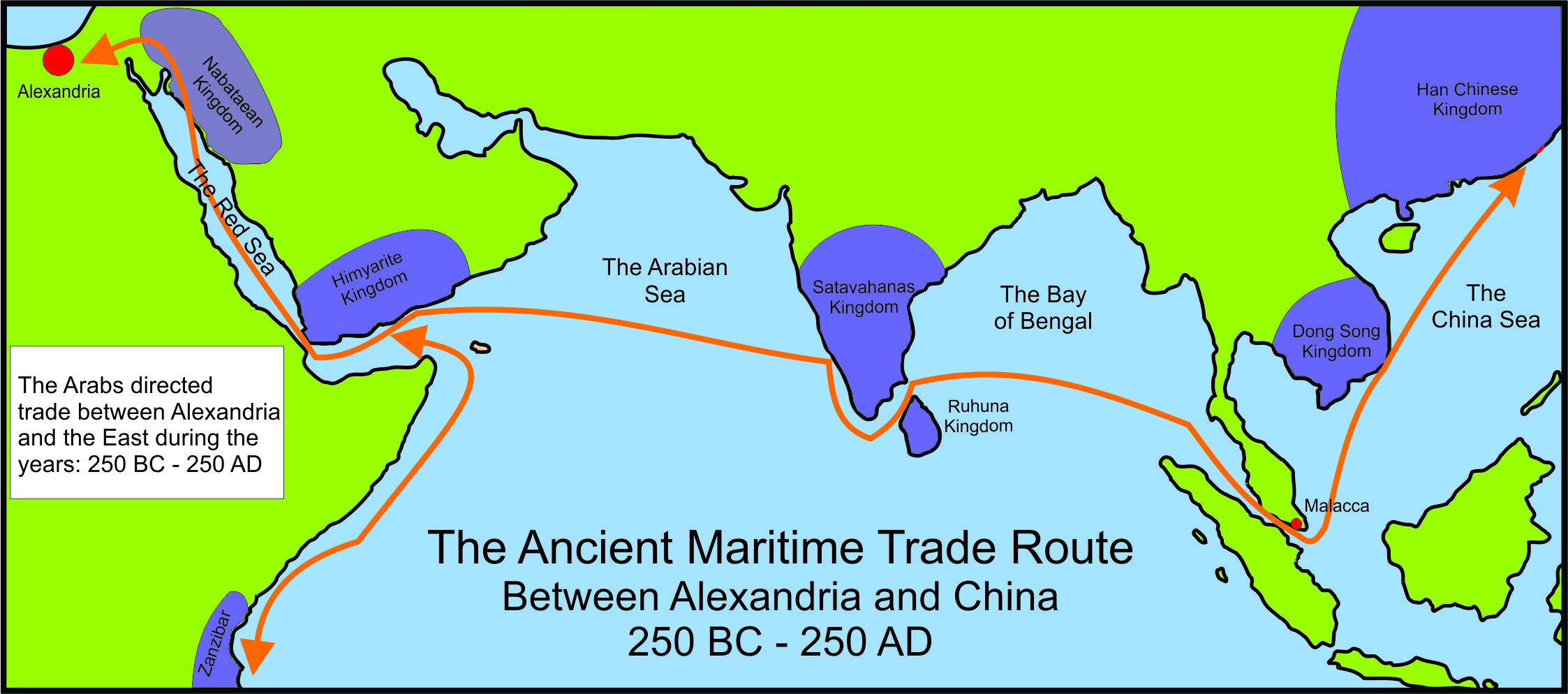
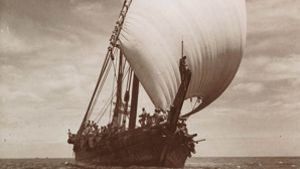
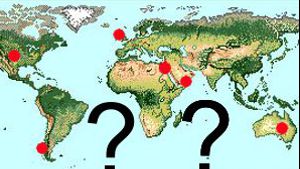
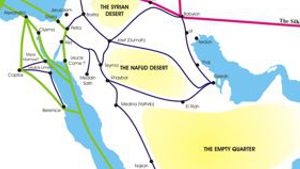
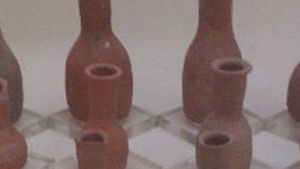
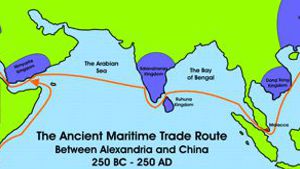





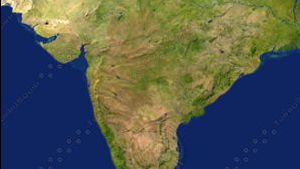
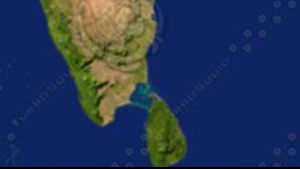

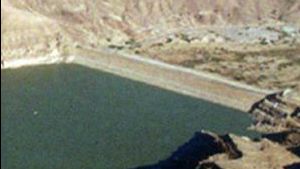
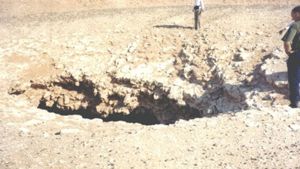

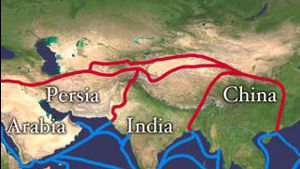
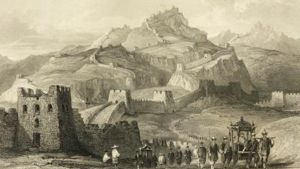
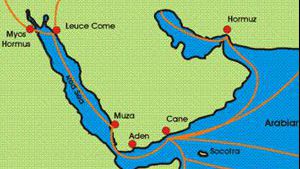
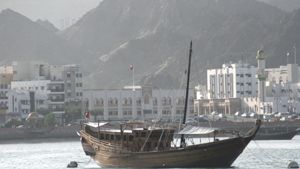
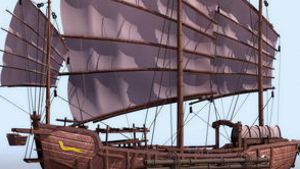
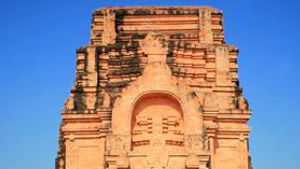

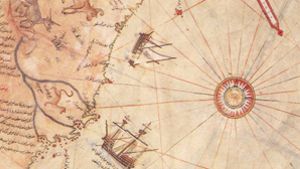
Page Discussion
Membership is required to comment. Membership is free of charge and available to everyone over the age of 16. Just click SignUp, or make a comment below. You will need a user name and a password. The system will automatically send a code to your email address. It should arrive in a few minutes. Enter the code, and you are finished.
Members who post adverts or use inappropriate language or make disrespectful comments will have their membership removed and be barred from the site. By becoming a member you agree to our Terms of Use and our Privacy, Cookies & Ad Policies. Remember that we will never, under any circumstances, sell or give your email address or private information to anyone unless required by law. Please keep your comments on topic. Thanks!